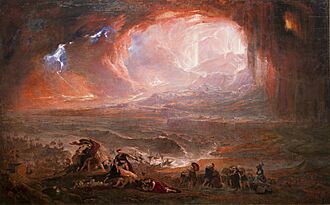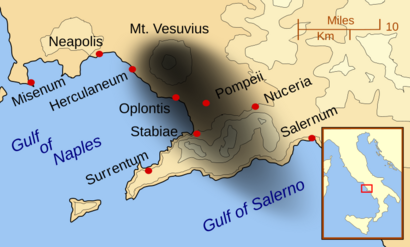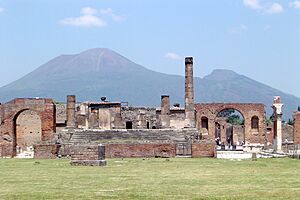Eruption of Mount Vesuvius in 79 AD facts for kids
Quick facts for kids Eruption of Mount Vesuvius in 79 AD |
|
|---|---|

The Destruction of Pompeii and Herculaneum (c. 1821) by John Martin
|
|
| Volcano | Mount Vesuvius |
| Date | c. October, 79 AD |
| Type | Plinian, Peléan |
| Location | Campania, Italy 40°49′17″N 14°26′34″E / 40.82139°N 14.44278°E |
| VEI | 5 |
| Impact | Buried the Roman settlements of Pompeii, Herculaneum, Oplontis, and Stabiae. |
| Deaths | 1,500–3,500, possibly up to 16,000 |
Mount Vesuvius is a famous volcano in Southern Italy. Its eruption in 79 AD is one of the most well-known and deadly in history.
In the autumn of 79 AD, Mount Vesuvius exploded with great force. It shot a huge cloud of super-hot ash and gases up to 33 kilometers (20 miles) high. It also threw out molten rock, pumice, and hot ash at an amazing speed. The eruption released a massive amount of energy, like 100,000 atomic bombs.
This event gave its name to a type of volcanic eruption called "Vesuvian." These eruptions create tall columns of hot gases and ash that reach very high into the sky. The 79 AD eruption also had fast-moving flows of hot gas and rock, known as pyroclastic flows.
The eruption destroyed several ancient Roman towns nearby. Pompeii and Herculaneum were completely buried under thick layers of ash and rock. Today, archaeologists have uncovered much of these towns. This helps us learn about the lives of the people who lived there. The area is now part of the Vesuvius National Park and a World Heritage Site.
More than 20,000 people lived in Pompeii and Herculaneum. So far, the remains of over 1,500 people have been found. The total number of deaths from the eruption is still unknown.
Contents
Signs Before the Eruption
A big earthquake hit the Bay of Naples area on February 5, 62 AD. It caused a lot of damage, especially in Pompeii. Some of this damage was still being fixed when Vesuvius erupted 17 years later.
Another smaller earthquake happened in 64 AD. The Roman writer Suetonius wrote about it. He said it happened while Emperor Nero was performing in a theater in Naples. Suetonius wrote that Nero kept singing even during the earthquake. Another writer, Tacitus, said the theater collapsed soon after people left it.
Minor earthquakes were felt in the four days before the 79 AD eruption. But people didn't see them as a serious warning. The people living near Vesuvius were used to small tremors. Pliny the Younger wrote that these tremors "were not particularly alarming because they are frequent in Campania."
How the Eruption Happened
Reconstructions of the eruption show similar main features, even if some details vary. The eruption lasted for two days. Pliny the Younger, who wrote the only eyewitness account, said the morning before the eruption seemed normal. He was staying in Misenum, about 29 kilometers (18 miles) from the volcano. The first day of the eruption didn't affect Misenum much.
Around 1:00 p.m., Mount Vesuvius exploded violently. It shot a tall column of ash and pumice into the sky. This material then began to fall, covering the area. Over the next few hours, people tried to rescue others or escape. Sometime during the night or early the next day, hot pyroclastic flows started near the volcano. People in Misenum saw lights on the mountain, which they thought were fires, and they fled.
These flows were fast, dense, and very hot. They knocked down buildings and burned or suffocated anyone still there. There were also more tremors and a small tsunami in the Bay of Naples. Some earthquakes were strong enough to make buildings collapse in Pompeii, killing people inside. By the evening of the second day, the eruption stopped affecting Misenum. Only a haze remained in the air, blocking the sunlight.
Pliny the Younger wrote:
broad flames shone out in several places from Mount Vesuvius, which the darkness of the night contributed to render still brighter and clearer... It was now day everywhere else, but there a deeper darkness prevailed than in the thickest night.
Eruption Phases and Effects

Scientists have studied the layers of ash and rock left by the eruption. They believe the eruption happened in two main phases, switching back and forth six times.
The first phase was a "Plinian" eruption. It sent a column of volcanic debris and hot gases 15 to 30 kilometers (9 to 19 miles) into the sky. This phase lasted 18 to 20 hours. It spread pumice and ash, creating a 2.8-meter (9.2 ft) layer to the south, towards Pompeii. An earthquake during this time caused buildings in Pompeii to collapse.
The next phase was a "Pelean" eruption. This produced fast-moving pyroclastic surges of molten rock and hot gases. These surges reached as far as Misenum to the west. Two powerful surges hit Pompeii, covering it with a 1.8-meter (5.9 ft) layer. These surges burned and suffocated anyone who had stayed behind. Herculaneum, Pompeii, and Oplontis were buried under fine pyroclastic deposits, pumice, and lava fragments up to 20 meters (66 ft) deep.
Scientists think surges 4 and 5 destroyed and buried Pompeii. These surges leave special patterns in the rock layers that are different from ash falling from the sky. The eruption was mainly "phreatomagmatic." This means it was powered by steam created when seawater mixed with hot magma deep underground.
The Two Plinys: Eyewitness Accounts
The only surviving eyewitness account comes from two letters written by Pliny the Younger. He was 17 years old when the eruption happened. He wrote these letters to the historian Tacitus about 25 years later.
Pliny the Younger saw the first volcanic activity from Misenum, across the Bay of Naples. This was about 29 kilometers (18 miles) from the volcano. His uncle, Pliny the Elder, was in charge of the Roman fleet there. Pliny the Elder decided to launch a rescue fleet and went himself to help a friend. His nephew chose not to go. One of the nephew's letters tells what he learned from witnesses about his uncle's experiences. In a second letter, Pliny the Younger describes what he saw after his uncle left.
Pliny the Younger's Story
Pliny the Younger saw a very thick cloud rising quickly above the mountain. He described it like a pine tree:
the appearance of which I cannot give you a more exact description of than by likening it to that of a pine-tree, for it shot up to a great height in the form of a very tall trunk, which spread itself out at the top into a sort of branches. [...] it appeared sometimes bright and sometimes dark and spotted, according as it was either more or less impregnated with earth and cinders.
These events, and a request for help by sea, made Pliny the Elder start rescue operations. His nephew tried to continue his normal life, studying and bathing. But that night, an earthquake woke him and his mother. They left their house for the courtyard. Another tremor at dawn made everyone in the village leave. After a third tremor, Pliny wrote that "the sea seemed to roll back upon itself." This was a sign of a tsunami. However, there isn't much evidence of widespread damage from waves.
A black cloud blocked the early morning light. Flashes of light, like lightning but bigger, shone through it. The cloud covered Misenum and the island of Capraia (Capri). Fearing for their lives, people started calling to each other and moving away from the coast. Pliny's mother asked him to leave her and save himself, as she was too old and heavy to go further. But he took her hand and led her away as best he could. Ash began to fall. Pliny had to shake off the ash often to avoid being buried. Later that day, the ash stopped falling. The sun shone weakly through the cloud, encouraging Pliny and his mother to go home. They waited for news of Pliny the Elder. Pliny compared the ash to a blanket of snow. The earthquake and tsunami damage there were not bad enough to stop them from using their home.
Pliny the Elder's Story
Pliny's uncle, Pliny the Elder, commanded the Roman fleet at Misenum. He decided to investigate the eruption up close in a small boat. As his ship was getting ready to leave, a messenger arrived. The messenger was from his friend Rectina, who lived near the volcano's base. She explained that her group could only escape by sea and asked for rescue. Pliny ordered the fleet's galleys to immediately start evacuating the coast. He continued in his small ship to rescue Rectina's group.
He sailed across the bay but ran into thick showers of hot ash, pumice, and rocks. His helmsman told him to turn back. But Pliny said, "Fortune favors the brave" and ordered him to continue to Stabiae. This town was about 4.5 kilometers (2.8 miles) from Pompeii. There, he met Pomponianus, who had already loaded a ship with belongings. Pomponianus was ready to leave, but the same wind that brought Pliny's ship there prevented anyone from leaving.
Pliny and his group saw flames coming from different parts of the mountain. Pliny and his friends thought these were burning villages. After staying overnight, the violent shaking of the building forced them outside. They woke Pliny, who had been napping and snoring loudly. They decided to go into the fields, tying pillows to their heads to protect themselves from falling rocks. They went back to the beach, but the wind had not changed. Pliny sat down on a sail spread for him and could not get up, even with help. His friends then left, eventually escaping by land.
It's likely Pliny the Elder collapsed and died. His nephew suggested his death was due to his weak lungs reacting to a cloud of poisonous, sulfurous gas. However, Stabiae was 16 kilometers (10 miles) from the volcano's vent. His companions seemed fine, so it's more likely that the heavy-set Pliny died from something else, like a stroke or heart attack. An asthma attack is also possible. His body was found the next day with no obvious injuries after the ash cloud had cleared.
People Lost in the Eruption
Besides Pliny the Elder, only a few other victims are known by name. These include the princess Drusilla and her son Agrippa. It's also said that the poet Caesius Bassus died in the eruption.
By 2003, about 1,044 casts of bodies had been found in and around Pompeii. These casts were made from the hollow spaces left by bodies buried in the ash. The scattered bones of another 100 people were also found. At Herculaneum, about 332 bodies have been found. The total number of deaths from the eruption is still unknown.
Herculaneum was closer to the volcano's crater. It was saved from the ashfall because of the wind direction. But it was buried under 23 meters (75 ft) of material from pyroclastic surges. Most, if not all, of the known victims in Herculaneum likely died from these surges. Evidence of high temperatures was found on the skeletons in the arched vaults by the seashore. Also, carbonized wood was found in many buildings. Many people were crowded into these vaults, perhaps boathouses, and were caught by the first surge. They died from thermal shock and were partly burned by later, hotter surges. Since only a small part of the coast has been excavated, more victims might still be found.
When Did the Eruption Happen?
Roman writers from the first century mention the Vesuvius eruption. But they don't say the exact day. For example, Josephus wrote that it happened "in the days of Titus Caesar." Suetonius, a historian from the second century, simply said, "There were some dreadful disasters during his reign, such as the eruption of Mount Vesuvius in Campania."
For a long time, until about 2018, most articles said the eruption began on August 24, 79 AD. This date came from a printed copy of Pliny the Younger's letter from 1508. But over many centuries of hand-copying, the date in Pliny's original letter might have changed. Experts believe the original date could have been August 24, October 30, November 1, or November 23. Most old handwritten copies point to August 24.
However, since the late 1700s, some archaeologists have suggested the eruption happened later, in autumn. In 1797, Carlo Rosini reported finding traces of autumn fruits and heaters in Pompeii and Herculaneum. These things suggested autumn, not summer.
More recently, in 1990 and 2001, archaeologists found more autumn fruits, like pomegranates. They also found victims wearing heavy clothing. Large storage jars filled with wine were also found. This suggests the eruption happened after the grape harvest, which is in autumn.
In 2007, a study of winds in Campania showed that the ash pattern from the eruption fits an autumn event. During June, July, and August, the winds usually blow to the west.
Also, coins found in Pompeii's House of the Golden Bracelet provide clues. These coins were minted during Emperor Titus's reign, which began on June 24, 79 AD. A coin expert from the British Museum concluded that the latest coin found was minted between June 24 and September 1, 79 AD. It's unusual for coins to enter circulation and reach Pompeii so quickly.
In October 2018, Italian archaeologists found a charcoal inscription that read "the 16th day before the calends of November." This means October 17. Since it was unlikely to be a year old, this sets the earliest possible date for the eruption. A study in 2022 determined the date to be October 24–25.
Images for kids
See also
- Buildings at Pompeii, including
- Villa Boscoreale
- Villa Poppaea
- "Pompeii" (song), a 2013 song by Bastille inspired by the eruption of Mount Vesuvius
- Villa of Agrippa Postumus



